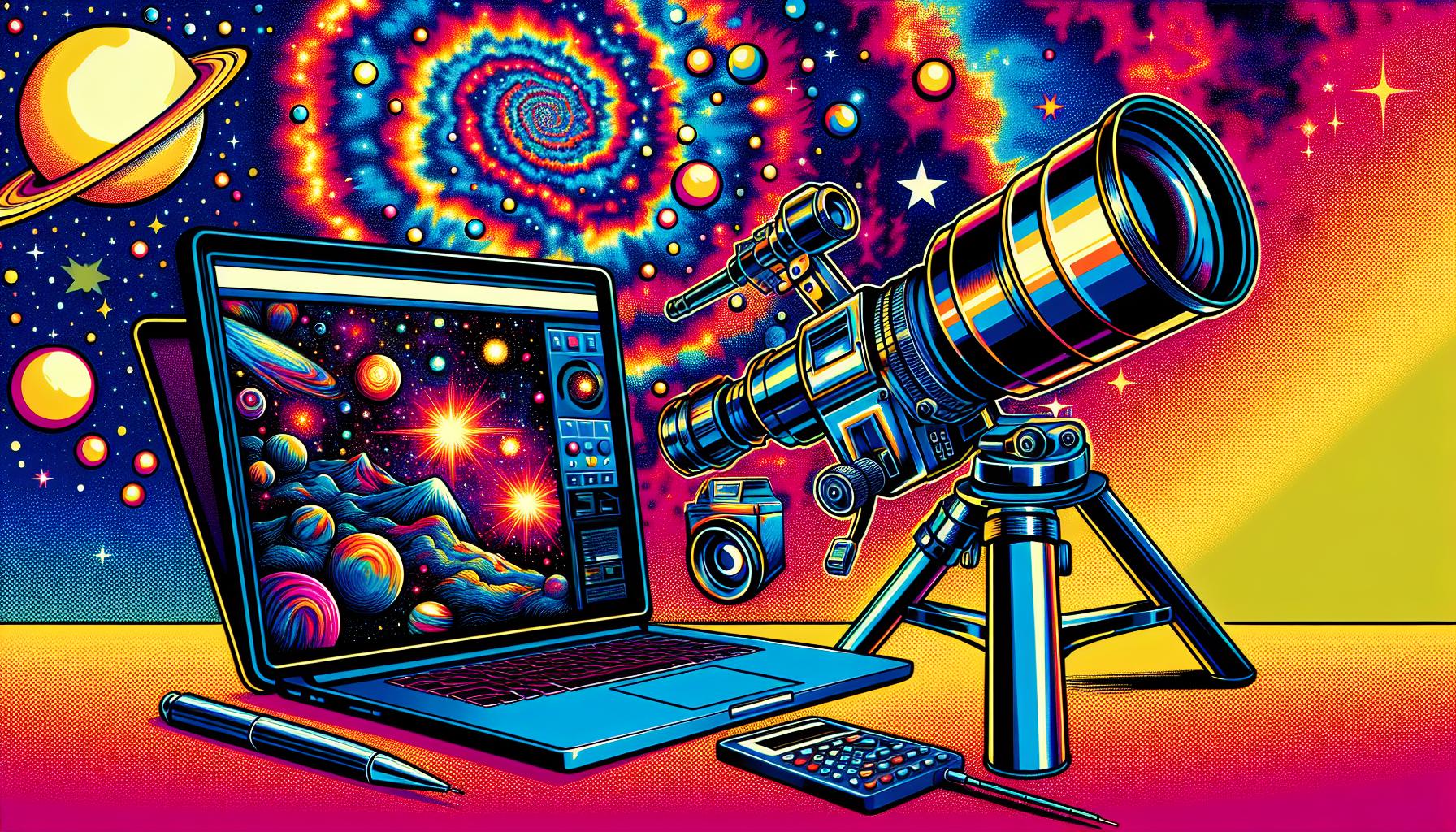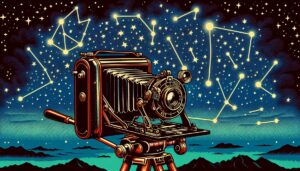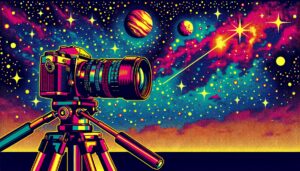This site contains affiliate links to products. I may receive a commission for purchases made through these links.
Astrophotography is not just about pointing your camera at the night sky and hoping for the best. It’s a delicate dance between technology and nature that requires the right tools. That’s where astrophotography software comes into play.
Whether you’re a novice stargazer or a seasoned astronomer, astrophotography software can transform your celestial snapshots into awe-inspiring works of art. These powerful programs help to enhance your images, reduce noise, and bring out the intricate details of the cosmos.
So, let’s delve into the world of astrophotography software, and discover how it can take your stargazing experience to a whole new level. From image stacking to post-processing, we’ll explore the best software options available, and how you can utilize them to capture the night sky like never before.
What is astrophotography software?
So, let’s unpack the term astrophotography software. At its core, astrophotography software is a specialized toolset. It’s designed to enhance the quality and clarity of photos taken of celestial objects. Be it the moon with its majestic craters or the star-studded canvas of the Milky Way, this software is your key to unlocking unbeatable detail and vibrancy in your space snapshots.
You may wonder how astrophotography software works. It’s a blend of intricate algorithms and high-precision adjustments. Essentially, it adjusts and optimizes image data to bring out the otherwise invisible details of the cosmos to the naked eye. It helps eliminate noise and adds sharpness to the image.
A variety of astrophotography software is available partitioned into different categories. Some focus on processing and post-processing cosmic images while others specialize in guiding your telescope to track stars, planets, or galaxies. These guiding software also help in stacking multiple images together to elicit a noise-free and detailed view of the cosmos.
To give you a rough idea, here are a few names from the vast realm of astrophotography software:
- Image Processing Software: Adobe Photoshop, PixInsight
- Stacking Software: DeepSkyStacker, Starry Landscape Stacker
- Guiding Software: AstroArt, PHD2 Guiding
Always remember, astrophotography is more an art than a science. The best software in the world won’t produce stunning results if not used properly. The secret lies in acquiring a good understanding of the specific features of the software and how to use them.
Bear in mind that most of these software demand a learning curve. That’s perfectly alright. A bit of trial and error, mixed with commitment and passion, is all it takes to master them. You’ll find yourself in awe when you start producing better and better shots of the heavenly bodies. Up ahead, we are going to dig a bit deeper into some of these software and shed light on their benefits and their functions.
Key features to look for in astrophotography software
Zooming into the vast universe from the comfort of my desktop has become a lifestyle. This journey isn’t without the right tools and top on the list is astrophotography software. But the market’s saturated with many options and it’s essential to spot software with the necessary features that will produce breathtaking celestial shots.
Depth and flexibility in image processing
Astrophotography is all about details. The software must provide depth and flexibility in image processing. This means a provision for varied adjustments like contrast, brightness, sharpness, and saturation to reveal hidden celestial wonders.
highly developed algorithms. This way, I’m able to seamlessly tweak images to bring out faint stars or nebulae that other less sophisticated programs might miss.
Stacking and guiding capabilities
Astrophotography is long exposure in essence. To capture enough light from distant objects the camera needs to open for longer periods. This creates a challenge. The earth rotates hence images can blur. A vital feature of astrophotography software is stacking; it aligns and combines multiple shots to enhance image quality.
Guiding software controls the camera and aligns it accurately with celestial bodies thereby eliminating blur due to the Earth’s rotation.
User-friendly interface
While software must deliver professional results, it shouldn’t be complex. The interface needs to be intuitive making navigation easy. I wouldn’t want to spend countless hours trying to locate a single function. Also, good software provides a step-by-step guide, ensuring even a beginner can capture stunning images of the Milky Way.
Compatibility with various devices
We live in a world where we use our PCs, laptops, tablets, or smartphones interchangeably. Therefore, the software should be adaptable, and functioning seamlessly across a variety of devices. This allows me to capture images anytime and from anywhere, whether I’m on a mobile phone or a high-powered desktop.
Keep in mind these crucial features next time you’re in the market for astrophotography software.
Top 4 astrophotography software options
Speaking from experience, DeepSkyStacker is often the first choice for beginners due to its free price tag and user-friendly nature. It specializes in stacking and calibrating astrophotography images which reduces the chance of blur caused by Earth’s rotation. Even though it lacks advanced editing tools, its simplicity attracts many novice astrophotographers.
In contrast, PixInsight is arguably the most powerful astrophotography software available. It’s renowned for its depth and flexibility in image processing. The wide range of available adjustments for contrast, brightness, sharpness, and saturation allows users to finely tweak images to their liking. It’s an especially strong choice for experienced users who want control over every aspect of their photos.
Then, we also have Adobe Photoshop. While it’s not exclusively targeted at astrophotographers, its versatility and powerful editing tools make it an attractive option nonetheless. It has robust capabilities in terms of image processing and adjustments, albeit lacking specialized astrophotography features like stacking and guiding.
Last but not least, Astro Pixel Processor (APP) consolidates the strengths from the previous options. Offering a comprehensive suite of astrophotography-tailored features, including top-notch stacking and guiding, APP also provides a user-friendly interface. Despite its slightly higher price point, it is compatible with various devices and its rich functionality and balanced usability make it a strong candidate in the market.
Conclusion
So, we’ve explored DeepSkyStacker, PixInsight, Adobe Photoshop, and Astro Pixel Processor, each offering unique advantages in the realm of astrophotography. DeepSkyStacker is a great starting point for novices, while PixInsight caters to those needing more advanced image processing. Adobe Photoshop’s versatility shines, even though it’s not astrophotography-specific. And let’s not forget Astro Pixel Processor, a comprehensive solution for all your astrophotography needs.
Finally, the best software for you depends on your personal requirements and proficiency level. So, don’t be afraid to experiment and find the one that suits your style. Happy stargazing!
Don’t forget to subscribe to our newsletter where you’ll find the latest cosmic discoveries, expert stargazing tips, and exclusive subscriber deals. Embark on your cosmic journey if you haven’t already!
FAQ
What are the key features to look for in astrophotography software?
Key features in astrophotography software include depth and flexibility in image processing, stacking, and guiding capabilities, a user-friendly interface, and compatibility with various devices.
What are the four top astrophotography software options?
DeepSkyStacker, PixInsight, Adobe Photoshop, and Astro Pixel Processor (APP) as top astrophotography software options.
Which software is recommended for beginners?
DeepSkyStacker is recommended for beginners due to its simplicity and free price tag.




